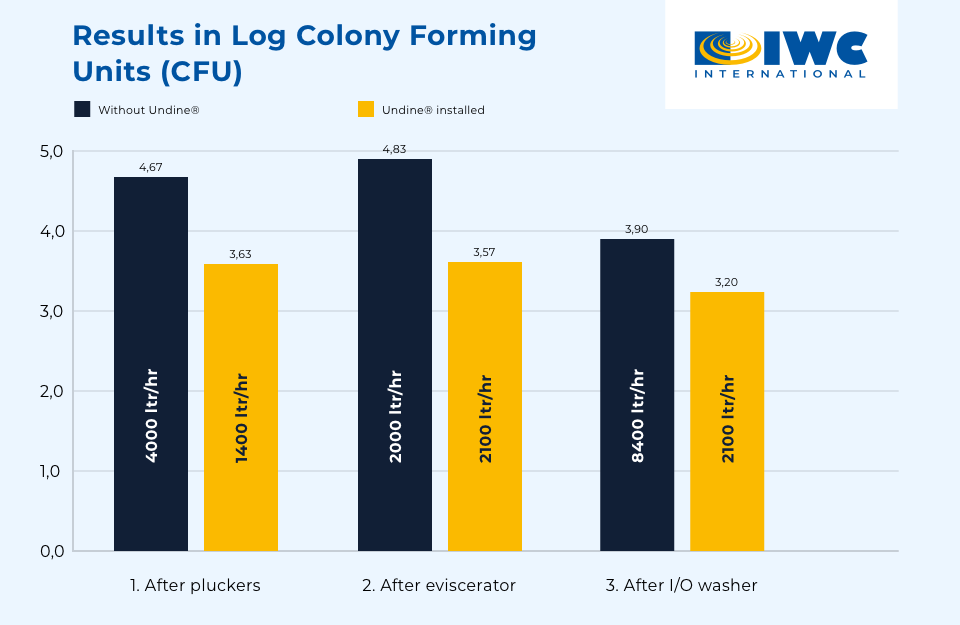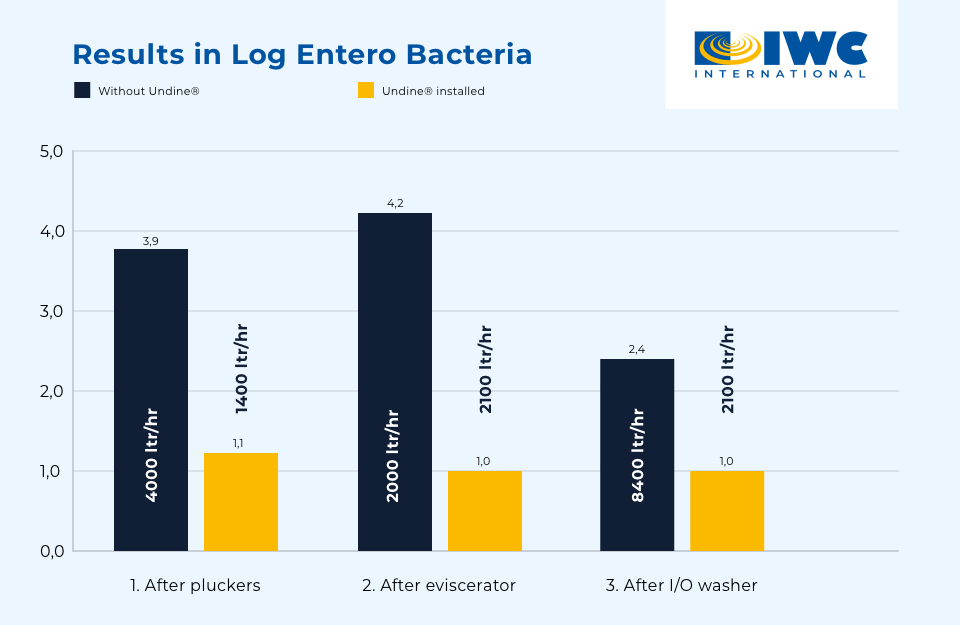Enormous reduction of bacteria by cleaning with Undine® immediately after plucking
| 26 March, 2020 | Ton Winters |
To demonstrate the need for cleaning after plucking, an Undine® outside washer was installed in a poultry processing line immediately after the last plucker. The purpose of this test was to measure the extent to which the hygiene of poultry products is improved by cleaning the products directly after plucking.
By cleaning directly after the pluckers, loose feathers, dirt and bacteria are removed from the products. The total bacterial count and the number of Enterobacteriaceae is measured at different positions in the line after the washer. The results of the test confirmed our statement convincingly. Read more in this article!
Why cleaning after plucking is essential
In the poultry processing industry, it is widely known that pluckers are in continuous contact with the product. The pluckers remove the feathers and do this with rotating rubber fingers that continuously scrape over the skin at high speed. Removal of the feathers creates empty feather follicles that are sealed with released contaminants.
When the product cools down, the feather follicles and the pores close almost immediately. The contamination present can then no longer be removed. The soiling in the pores and feather follicles must therefore be removed within 10 seconds after leaving the pluckers.
Design of the test with Undine®
The tests were carried out in a commercial poultry processing line with a line speed of 14,000 bph. The processing line transports the chickens through the evisceration department to the chillers. At the end of the evisceration process, a standard OEM I/O washer is installed for final cleaning, followed by an air cooling system with humidification nozzles to prevent dehydration.
Test samples for bacteriological examination were taken from the product. In a production week of five days in total, several samples were taken. Two days without the Undine® washer, and three days with the Undine® washer. Furthermore, the samples were taken at three positions in the line at several times a day:
- After the Undine® cabin at the end of the pluckers
- At the end of the evisceration line, just before the standard OEM I/O washer
- At the end of the evisceration line, after the standard OEM I/O washer
The samples were taken at the start of production (0), and after 5 and 8 hours of production. For each sample, three carcasses were swabbed per position. The total colony forming units (CFU) and the number of Enterobacteriaceae were analyzed from the samples. A total of 225 samples were taken.
The total colony forming units (CFU) and the number of Enterobacteriaceae were analyzed in two situations:
- Before installation of the Undine® washer
- With the Undine® washer in operation
Results: CFU reduction of 1 log

With the Undine® washer operational, the results show a CFU reduction of no less than 1 log immediately after the Undine® washer. This positive effect remains throughout the entire evisceration process. At the end, after the OEM’s I/O washer, there is still a reduction of the total CFU of 0.7 log.
In the evisceration line, new (cross) contaminations can occur in the machines. Also, manual actions can be a cause of this (e.g. by damaged intestines). These new infections reduce the effect of the washer after plucking. This explains why the number of bacteria rises slightly after plucking without an operational Undine® washer at this point in the process.
Besides improving hygiene, Undine® also saves a lot of water. Figure 1 shows the water consumption for each step of the process for both a standard OEM solution and for Undine®.
Results: huge reduction of Enterobacteriaceae and water consumption

The Undine® washer after the pluckers reduced the number of Enterobacteriaceae to 1 log, as <10 is noted as 10 in the results. This means that the Enterobacteriaceae are almost completely washed away compared to the situation without Undine®.
An additional conclusion that can be drawn from the test, is that bacterial load increases during production. The samples taken after 8 hours of production have a higher bacterial load. As more products enter the process, the bacterial load on the machines also increases. The total CFU also increases, but structurally at a lower level. For Enterobacteriaceae, however, this effect is minimized on days when the Undine® washer was operational.
Again, it appears that Undine® not only improves hygiene, but also saves a lot of water. The graph shows the water consumption in that step of the process for the standard OEM solution and Undine®.
Undine®: a revolutionary step in the fight against contamination in slaughterhouses
The study confirmed that pluckers are a significant source of microbiological contamination in slaughterhouses. This is particularly true for bacteria on the outside of poultry, such as Enterobacteriaceae. Thoroughly cleaning the carcasses after the last plucker is just as important for a safe, high quality product as proper cleaning of the carcasses in the evisceration line. Many bacteria are found in the pores and feather follicles in the skin.
Research has shown that skin pores and feather follicles can only be cleaned immediately after the plucking process, as they close shortly after plucking. Therefore, a washer is only effective if it is used within 10 seconds of the last plucker. After this time, bacteria and dirt can no longer be removed from closed pores and follicles.
The washer after the plucker is only part of the solution: it cleans the outside of the product. For example, additional washers need to be installed in the evisceration line to further reduce the bacterial load and to keep it low. After each step in the process where contamination is a risk, cleaning should take place. The more cleaning moments, the lower the bacterial load and the greater the certainty that the bacterial load remains at this low level.
We know which solution is right for you
Do you also want to improve hygiene and save on water, energy and personnel costs? Don’t hesitate to contact us. You can call +31 (0) 527 745 932. Together with you, we will look for the best solution. Then, we will make you a proposal, including the ROI and a quotation.
 +31 (0) 527 745 932
+31 (0) 527 745 932 info@iwc-international.com
info@iwc-international.com




